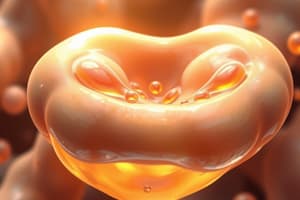Podcast
Questions and Answers
Which of these is NOT a lipid?
Which of these is NOT a lipid?
- Phospholipids
- Cholesterol
- Triglycerides
- RNA (correct)
This figure is an example of a(n) _____
This figure is an example of a(n) _____
saturated fat
Which of these is a phospholipid?
Which of these is a phospholipid?
Which of these is rich in unsaturated fats?
Which of these is rich in unsaturated fats?
A function of cholesterol that does not harm health is its role _____
A function of cholesterol that does not harm health is its role _____
Which statement most accurately explains why cholesterol and phospholipids are amphipathic but fats are not?
Which statement most accurately explains why cholesterol and phospholipids are amphipathic but fats are not?
Steroids are considered to be lipids because they _____
Steroids are considered to be lipids because they _____
Molecules that are amphipathic must contain _____
Molecules that are amphipathic must contain _____
Lipids are insoluble in water because _____
Lipids are insoluble in water because _____
Which of the following is true of membrane lipids?
Which of the following is true of membrane lipids?
The presence of many C-C and C-H bonds causes fats to be...
The presence of many C-C and C-H bonds causes fats to be...
What is the role of glycerol in fat synthesis?
What is the role of glycerol in fat synthesis?
In fat synthesis, ________ and fatty acids combine to make fats plus ________.
In fat synthesis, ________ and fatty acids combine to make fats plus ________.
In the reaction that builds a fat, ________ groups react with ________ groups.
In the reaction that builds a fat, ________ groups react with ________ groups.
Triglycerides vary with respect to the number of...
Triglycerides vary with respect to the number of...
What happens when a food company hydrogenates a barrel of fat?
What happens when a food company hydrogenates a barrel of fat?
The most unsaturated fats have...
The most unsaturated fats have...
What do DNA, proteins, and fats have in common?
What do DNA, proteins, and fats have in common?
What does cholesterol have in common with sex hormones?
What does cholesterol have in common with sex hormones?
For good health, why shouldn't your body run the LDL part of this diagram faster than the HDL part?
For good health, why shouldn't your body run the LDL part of this diagram faster than the HDL part?
Flashcards are hidden until you start studying
Study Notes
Lipids Overview
- Lipids are a diverse group of molecules characterized by their insolubility in water.
- Key forms of lipids include fats, phospholipids, and steroids.
Non-Lipids
- RNA is not considered a lipid.
Types of Fats
- Saturated Fats: Solid at room temperature, typically found in animal products.
- Unsaturated Fats: Found in oils like olive oil, which remain liquid at room temperature and have beneficial health effects.
Phospholipids and Cholesterol
- Phospholipids are essential components of cell membranes, featuring hydrophilic (water-attracting) heads and hydrophobic (water-repelling) tails.
- Cholesterol, like phospholipids, is amphipathic, meaning it has both hydrophilic and hydrophobic regions, unlike fats which are primarily hydrophobic.
- Cholesterol helps stabilize cell membranes and is not harmful in appropriate amounts.
Structure and Composition
- Molecules classified as amphipathic have both hydrophilic and hydrophobic regions, crucial for forming membranes.
- The insolubility of lipids in water is primarily due to the presence of nonpolar C-C and C-H bonds.
- Membrane lipids typically consist of a hydrophilic head and a hydrophobic tail structure.
Synthesis of Fats
- Fats are synthesized when glycerol combines with fatty acids, releasing water as a byproduct.
- Hydroxyl groups of glycerol react with carboxyl groups of fatty acids during fat formation.
Properties of Triglycerides
- Triglycerides vary based on the number of carbon atoms and double bonds in their fatty acid tails.
- The more carbon and double bonds a fat has, the more unsaturated it is and, consequently, more fluid in nature.
Hydrogenation
- Hydrogenating fats decreases their fluidity, turning them into more solid forms.
Comparisons Among Biomolecules
- DNA, proteins, and fats all share the presence of carbonyl groups in their structures.
- Cholesterol and sex hormones are similar due to their structural feature of four linked rings.
Health Implications of Cholesterol
- Maintaining a balance between LDL (low-density lipoprotein) and HDL (high-density lipoprotein) is vital for health; excessive LDL can lead to storage of cholesterol, while HDL helps in its breakdown.
Studying That Suits You
Use AI to generate personalized quizzes and flashcards to suit your learning preferences.




